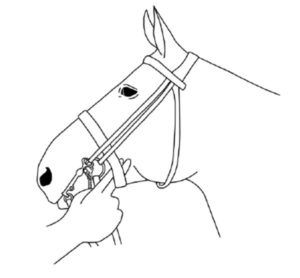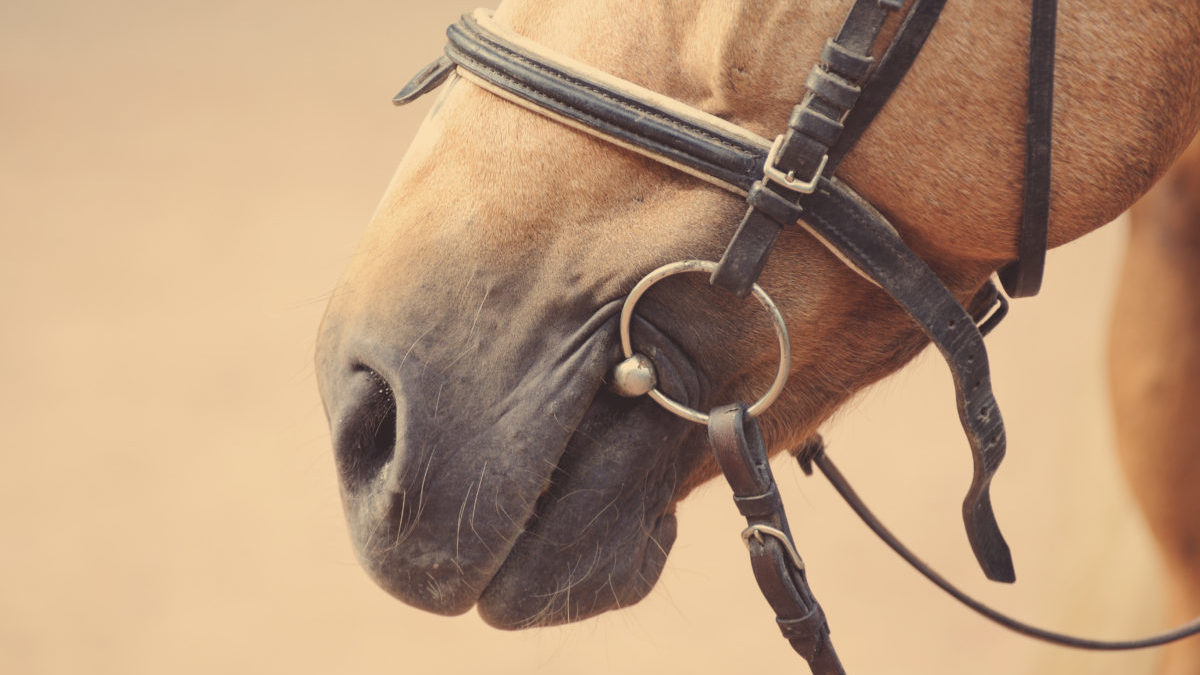Choosing the right bit and noseband for your horse can be a process of trial and error. But it’s worth it, since how they fit affects his comfort level – and the prevalence of oral lesions.
If you’re purchasing a bit and noseband, you need to ensure you’re choosing what’s right for your horse. Your decision should be based on what’s comfortable for him, what fits him well and affords an appropriate level of control without putting undue pressure on him. Every horse is different and it may require a certain amount of trial and error to find the equipment that works best. In this article we’ll look at the results of some recent studies related to the selection and adjustment of nosebands and bits, and their association with oral lesions.
Cheek biting happens
The most frequent sites for oral abrasions or ulcers in horses are the insides of the cheeks and the corners of the lips. Lesions inside the cheeks occur when the loose, flabby cheek tissue rubs against or is accidentally bitten by the horse’s premolar teeth. The upper premolars tend to develop sharp enamel points on their outer edges which are liable to abrade the cheeks as they rub against the teeth.
This isn’t a problem limited only to ridden horses. In a group of brood mares that had not been ridden for at least 11 months, and that had their teeth floated regularly, more than half had oral ulcers, indicating that even unridden horses can accidentally bite their own cheeks. However, research has shown that oral ulcers occur in over 90% of horses ridden regularly with a bit and bridle, demonstrating that the prevalence of oral ulcers is higher in ridden horses than in those with a sedentary lifestyle.
What kind of noseband?
A tight noseband compresses the cheeks and may increase the likelihood that the teeth will injure the cheeks. The risk of injury varies, however, according to the position of the noseband strap.
A cavesson noseband, or the upper strap of the crossed noseband or Micklem bridle, encircles the head directly over the premolars. When these straps are tightened, the cheeks are pressed more firmly against the teeth, which facilitates abrasions of the cheeks.
Generally, a drop noseband, a flash noseband or the lower strap of a crossed (Mexican) noseband or Micklem bridle fit in front of the premolar teeth and do not squeeze the cheeks against the teeth.

©2018 United States Equestrian Federation, Inc. (USEF) Reprinted with permission of USEF. All rights reserved. Reproduction without permission is prohibited by law. USEF is not responsible for any errors or omissions in the publication or for the use of its copyrighted materials in any unauthorized manner.
Adjusting the noseband
The traditional recommendation is that it should be possible to insert two fingers between the noseband and the horse’s face. It’s safest to check this on the side of the face, just behind the headpiece of the noseband, as recommended in the USEF rule book (see illustration). On no account should you put your fingers between the noseband and the bridge of the horse’s nose – if the horse opens his mouth, your fingers could be crushed. The International Society for Equitation Science markets a taper gauge that can be used to measure tightness of the noseband at the bridge of the nose.
When the noseband is adjusted as recommended above, it acts as a training aid. If the horse opens his mouth, the noseband automatically tightens and applies pressure to his face. When the mouth closes, the pressure is immediately relieved. This applies the principle of negative reinforcement; noseband pressure is relieved when the horse closes his mouth. On the contrary, when the noseband is over-tightened to prevent the horse from resisting the action of the bit by opening his mouth, it applies pressure continuously with no relief for good behavior.
The areas of highest pressure under the noseband are at the edges of the nasal bones and under the jaw where the noseband crosses the mandibles. High pressure is also applied to these areas when using bitless bridles. It is beneficial for the noseband to have soft padding in areas where it crosses the bony parts of the face.
Bit selection
The bit lies in the oral diastema, the toothless area of the bars in front of the premolar teeth. The tongue usually acts as a cushion between the bit and the bars of the mouth (see image below). Depending on the type of bit, it may apply pressure to the bars, palate, tongue or lips. Bit selection, therefore, affects the parts of the mouth that are susceptible to injury.

In a study of Icelandic horses, lesions around the corners of the lips were associated specifically with the use of a snaffle bit, especially if the mouthpiece was either too wide or too narrow for the size of the horse’s mouth. On the other hand, damage to the bars of the mouth was associated with the use of a ported curb bit due to the leverage effect; when tension is applied to the reins, the port presses forward against the horse’s palate and the mouthpiece presses against the bars. Bit-related lesions of the tongue are not common but have been reported in polo ponies ridden with a gag bit.
A study of Danish sport horses that were examined during competitions revealed oral lesions or blood at the corners of the lips in 9% of horses, with more lesions in horses competing at higher levels. There was no difference in the prevalence of lesions between different bits or with bitless bridles.
Reducing the risk
What can we do to reduce the risk of oral lesions related to training and riding? First, we must realize that horses have oral ulcers even without being ridden and that regular dental care does not prevent these ulcers from developing. However, regular dental care should be part of our preventative medicine program to maintain oral health and to minimize the number and severity of ulcers.
Regular dental care should be part of our preventative medicine program to maintain oral health and to minimize the number and severity of ulcers.
We should take care that our tack and equipment, especially the bit and upper noseband strap, are correctly fitted and adjusted; the bit should be just a little wider than the distance between the corners of the lips, and thin enough to fit within the oral cavity. Very fat bits may be uncomfortable because there isn’t room for the horse to accommodate the bit with the jaws closed. The noseband should not be over-tightened.
The bit should be just a little wider than the distance between the corners of the lips, and thin enough to fit within the oral cavity
Finally, although the bit and the noseband affect the prevalence of oral lesions, neither riding bitless nor removing the noseband will protect the horse against the development of oral ulcers.







